A Bidirectional Quasi-Endfire Patch Antenna with Low Elevation Angle
Abstract
:1. Introduction
2. Antenna Design
2.1. Antenna Configuration
2.2. Antenna Operating Mechanism
2.3. Parametric Analysis on LP2, WP2, and g
2.4. Research on the Bidirectional Quasi-Endfire Patch Antenna with Multiple Shortened Patches
3. Results and Discussion
4. Conclusions
Author Contributions
Funding
Data Availability Statement
Conflicts of Interest
References
- Ye, M.; Li, X.R.; Chu, Q.X. Single-layer single-fed endfire antenna with bidirectional circularly polarized radiation of the same sense. IEEE Antennas Wirel. Propag. Lett. 2017, 16, 621–624. [Google Scholar] [CrossRef]
- Hu, J.; Hao, Z.C.; Fan, K.; Guo, Z. A bidirectional same sense circularly polarized endfire antenna array with polarization reconfigurability. IEEE Trans. Antennas Propag. 2019, 67, 7150–7155. [Google Scholar] [CrossRef]
- Liang, Z.; Lv, S.; Li, Y.; Liu, J.; Long, Y. Compact folded slot antenna and its endfire arrays with high gain and vertical polarization. IEEE Antennas Wirel. Propag. Lett. 2020, 19, 786–790. [Google Scholar] [CrossRef]
- Yan, Y.D.; Jiao, Y.C.; Zhang, C. A circularly polarized-reconfigurable planar end-fire antenna with bidirectional radiation of same sense and wide beamwidth. Int. J. RF Microw. Comput. Eng. 2020, 30, e22469. [Google Scholar] [CrossRef]
- Ke, Y.H.; Yang, L.L.; Chen, J.X. Design of switchable dual-Balun feeding structure for pattern-reconfigurable endfire antenna. IEEE Antennas Wirel. Propag. Lett. 2021, 20, 1463–1467. [Google Scholar] [CrossRef]
- Huang, Y.X.; Yan, Y.X.; Yu, W.; Qin, W.; Chen, J.X. Integration design of millimeter-wave bidirectional endfire filtenna array fed by SIW filtering power divider. IEEE Antennas Wirel. Propag. Lett. 2022, 21, 1457–1461. [Google Scholar] [CrossRef]
- Chen, C.; Guo, Y.; Wang, H. Wideband symmetrical cross-shaped probe dual-beam microstrip patch antenna. IEEE Antennas Wirel. Propag. Lett. 2015, 14, 622–625. [Google Scholar] [CrossRef]
- Li, J.F.; Chen, Z.N.; Wu, D.L.; Zhang, G.; Wu, Y.J. Dual-beam filtering patch antennas for wireless communication application. IEEE Trans. Antennas Propag. 2018, 66, 3730–3734. [Google Scholar] [CrossRef]
- Li, J.F.; Mao, C.H.; Wu, D.L.; Ye, L.H.; Zhang, G. A dual-beam wideband filtering patch antenna with absorptive band-edge radiation nulls. IEEE Trans. Antennas Propag. 2021, 69, 8926–8931. [Google Scholar] [CrossRef]
- Khidre, A.; Lee, K.F.; Elsherbeni, A.Z.; Yang, F. Wide band dual-beam U-slot microstrip antenna. IEEE Trans. Antennas Propag. 2013, 61, 1415–1418. [Google Scholar] [CrossRef]
- Liu, S.; Qi, S.S.; Wu, W.; Fang, D.G. Single-feed dual-band single/dual-beam U-slot antenna for wireless communication application. IEEE Trans. Antennas Propag. 2015, 63, 3759–3764. [Google Scholar] [CrossRef]
- Lu, H.; Liu, F.; Liu, Y.; Huang, S.; Principle, A.O. Single-layer single-patch wideband dual-beam E-shaped patch antenna. In Proceedings of the 2017 IEEE 5th International Symposium on Electromagnetic Compatibility (EMC-Beijing), Beijing, China, 28–31 October 2017. [Google Scholar]
- Yang, G.; Li, J.; Xu, R.; Yang, J.; Qi, Y. Dual-band single/dual-beam slot patch antenna. In Proceedings of the 2018 IEEE International Symposium on Antennas and Propagation & USNC/URSI National Radio Science Meeting, Boston, MA, USA, 8–13 July 2018. [Google Scholar]
- Kumari, P.; Das, S. A MIMO antenna system using self-decoupled EMSIW dual-beam antenna elements. IEEE Access 2022, 10, 1339–1345. [Google Scholar] [CrossRef]
- Ellis, M.S.; Nourinia, J.; Ghobadi, C.; Hosseini, K.; Alizadeh, F.; Mohammadi, B. Compact wideband printed antenna with circularly polarized tilted beam radiation using a quasi-radiator. AEU Int. J. Electron. Commun. 2023, 171, 154883. [Google Scholar] [CrossRef]
- Wang, R.; Wang, B.Z.; Ding, X. Broadband quasi-bidirectional antenna with vertical polarization. IEEE Antennas Wirel. Propag. Lett. 2018, 17, 2232–2236. [Google Scholar] [CrossRef]
- Shukla, P.K.; Sikandar; Tripathi, V.S.; Sharma, A. Dual band circularly polarized partially reflecting surface-loaded dielectric resonator-based MIMO antenna for mm-wave 5G applications. Int. J. Microw. Wirel. Technol. 2024, 1–10. [Google Scholar] [CrossRef]
- Zhu, B.; Yang, D.; Pan, J.; Chen, Y.; Liu, S. A low-profile metasurface-inspired antenna with tilted beam radiation. IEEE Antennas Wirel. Propag. Lett. 2023, 22, 1803–1807. [Google Scholar] [CrossRef]
- Huang, J. Planar microstrip Yagi array antenna. IEEE Antennas Propag. Soc. AP-S Int. Symp. 1989, 2, 894–897. [Google Scholar]
- Liu, J.; Xue, Q. Microstrip magnetic dipole Yagi array antenna with endfire radiation and vertical polarization. IEEE Trans. Antennas Propag. 2013, 61, 1140–1147. [Google Scholar] [CrossRef]
- DeJean, G.R.; Tentzeris, M.M. A new high-gain microstrip Yagi array antenna with a high front-to-back (F/B) ratio for WLAN and millimeter-wave applications. IEEE Trans. Antennas Propag. 2007, 55, 298–304. [Google Scholar] [CrossRef]
- DeJean, G.R.; Thai, T.T.; Nikolaou, S.; Tentzeris, M.M. Design and analysis of microstrip bi-Yagi and quad-Yagi antenna arrays for WLAN applications. IEEE Antennas Wirel. Propag. Lett. 2007, 6, 244–248. [Google Scholar] [CrossRef]
- Thai, T.T.; DeJean, G.R.; Tentzeris, M.M. Design and development of a novel compact soft-surface structure for the front-to-back ratio improvement and size reduction of a microstrip Yagi Array Antenna. IEEE Antennas Wirel. Propag. Lett. 2008, 7, 369–373. [Google Scholar] [CrossRef]
- Shi, J.; Zhu, L.; Liu, N.; Wu, W. A novel microstrip Yagi antenna with an improved end-fire radiation pattern under operation of the TM20 mode. Int. J. RF Microw. Comput. Eng. 2019, 29, e21789. [Google Scholar]
- Shi, J.; Zhu, L.; Liu, N.W.; Wu, W. A microstrip Yagi antenna with an enlarged beam tilt angle via a slot-loaded patch reflector and pin-loaded patch directors. IEEE Antennas Wirel. Propag. Lett. 2019, 18, 679–683. [Google Scholar] [CrossRef]
- Guo, E.; Liu, J.; Long, Y. A mode-superposed microstrip patch antenna and its Yagi array with high front-to-back ratio. IEEE Trans. Antennas Propag. 2017, 65, 7328–7333. [Google Scholar] [CrossRef]
- Dutta, R.K.; Jaiswal, R.K.; Saikia, M.; Srivastava, K.V. A two-stage beamforming antenna using Butler matrix and reconfigurable frequency selective surface for wide angle beam tilting. IEEE Antennas Wirel. Propag. Lett. 2023, 22, 2342–2346. [Google Scholar] [CrossRef]
- Wang, P.; Wu, Q.; He, R.; Shao, Y. Design of low profile and wideband end-fire antenna using metasurface. IEEE Access 2020, 8, 35752–35758. [Google Scholar] [CrossRef]
- Ashraf, M.; Jamil, K.; Telba, A.; Alzabidi, M.; Sebak, A. Design and development of a wideband planar yagi antenna using tightly coupled directive element. Micromachines 2020, 11, 975. [Google Scholar] [CrossRef]
- Balanis, C. Antenna Theory: Analysis and Design, 3rd ed.; Wiley: Hoboken, NJ, USA, 2005. [Google Scholar]
- Cassivi, Y.; Perregrini, L.; Arcioni, P.; Bressan, M.; Wu, K.; Conciauro, G. Dispersion characteristics of substrate integrated rectangular waveguide. IEEE Microw. Wirel. Compon. Lett. 2002, 12, 333–335. [Google Scholar] [CrossRef]
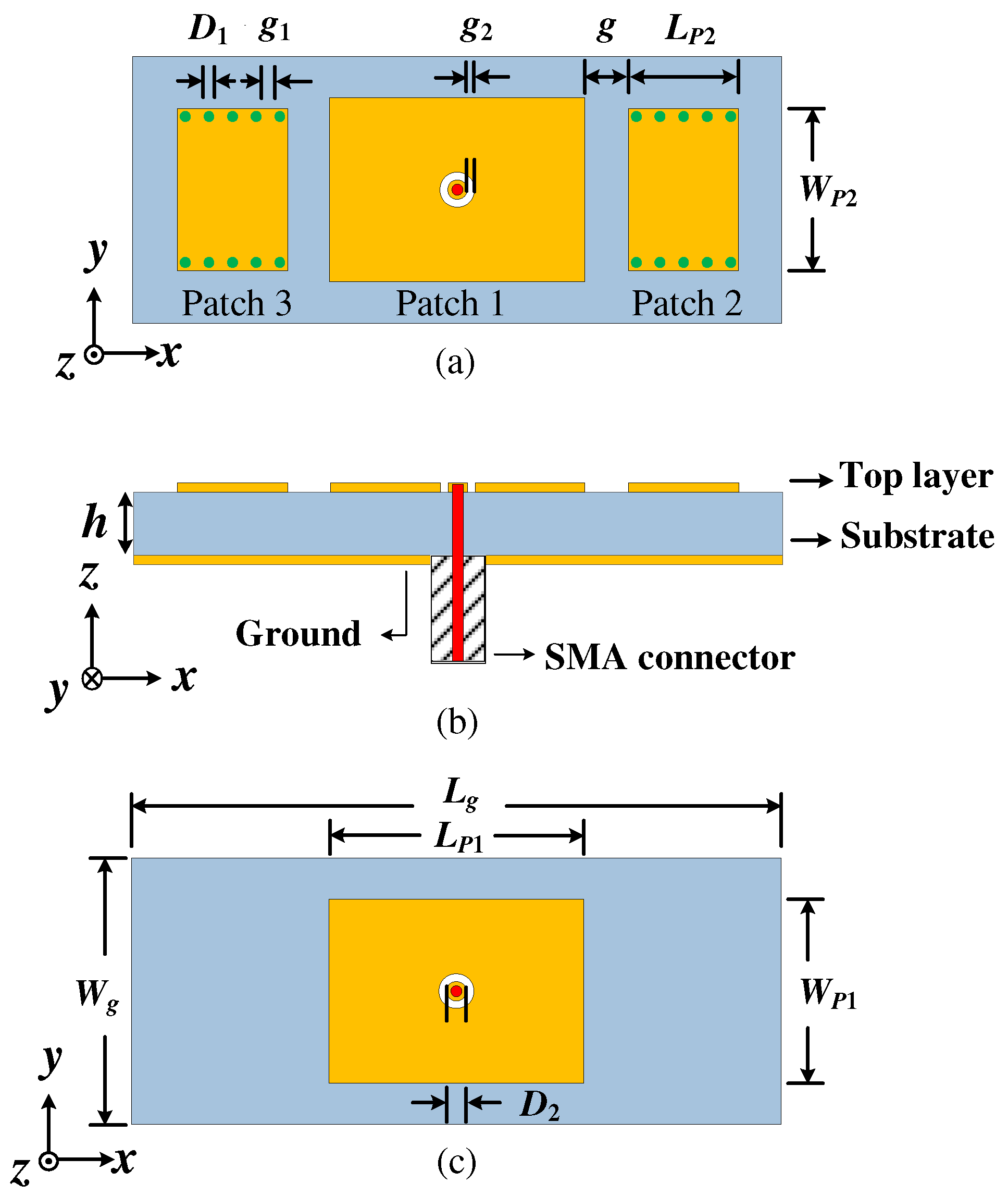
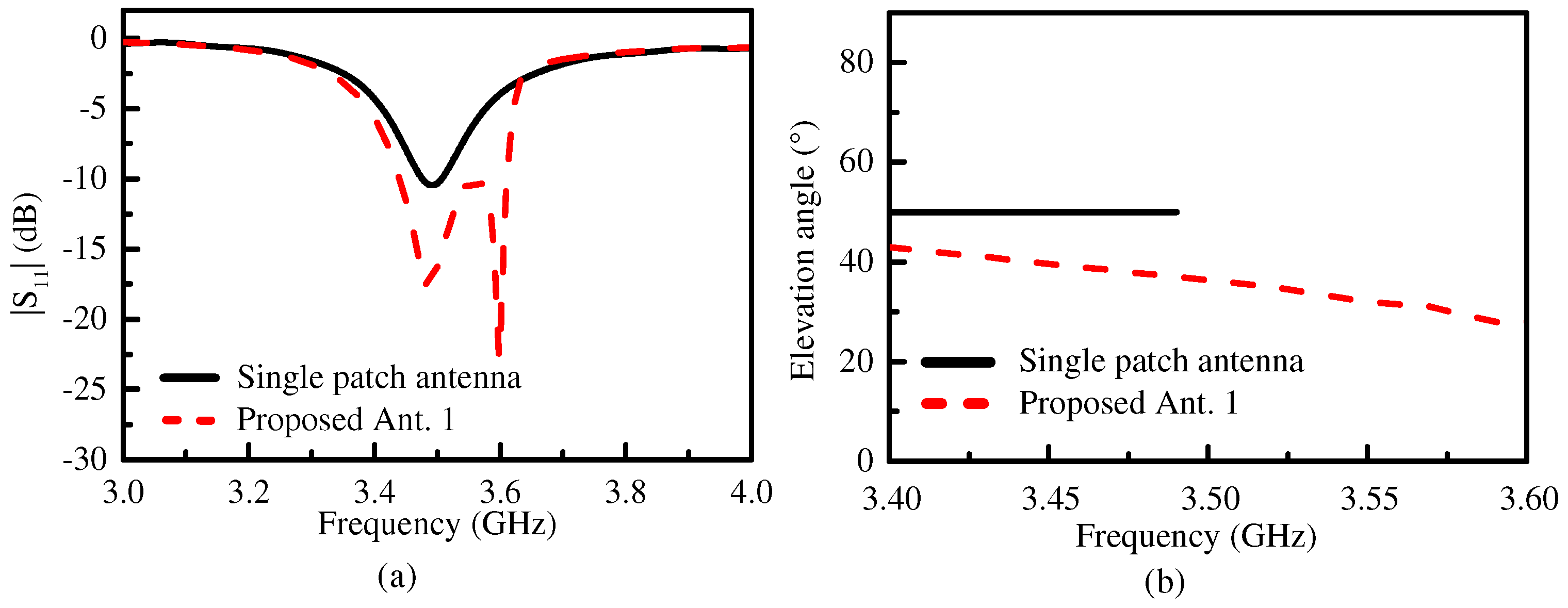

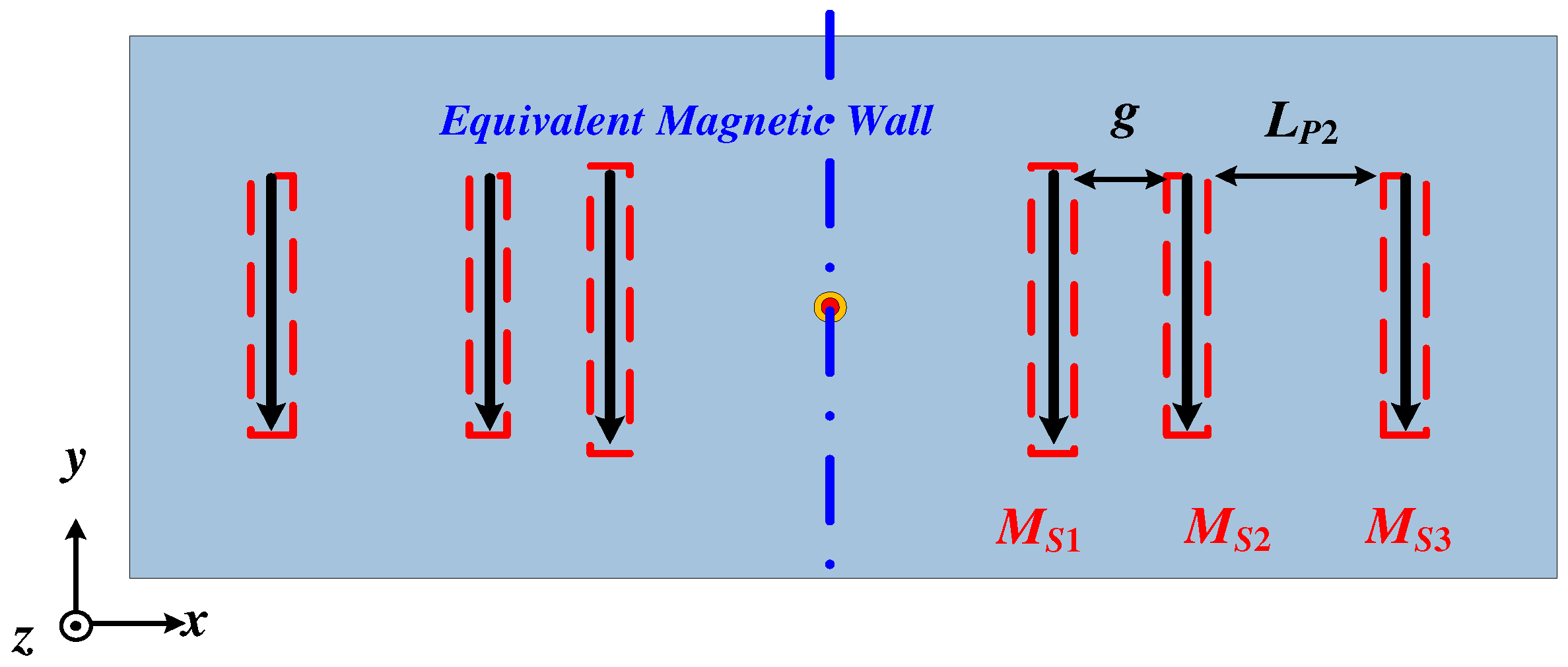


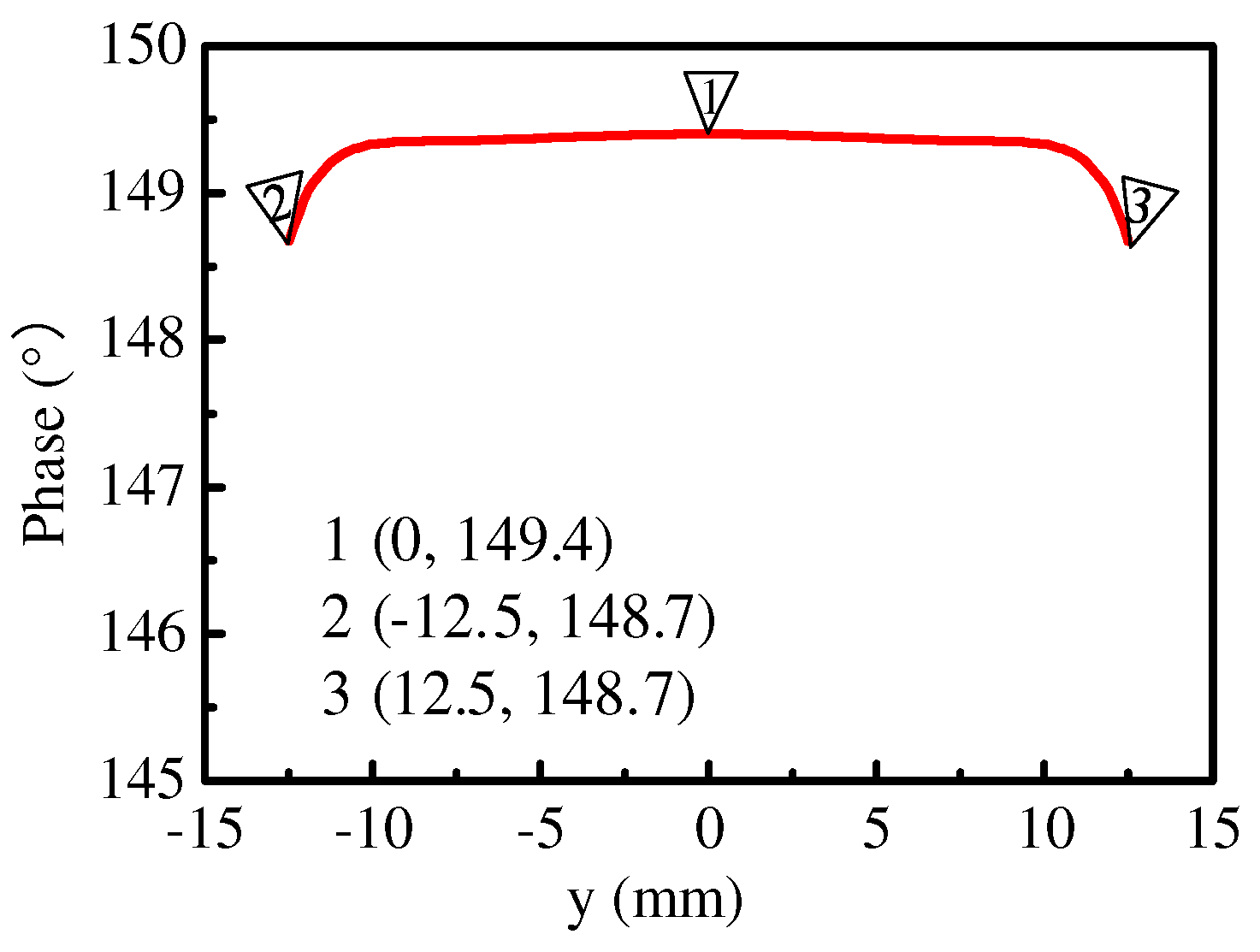
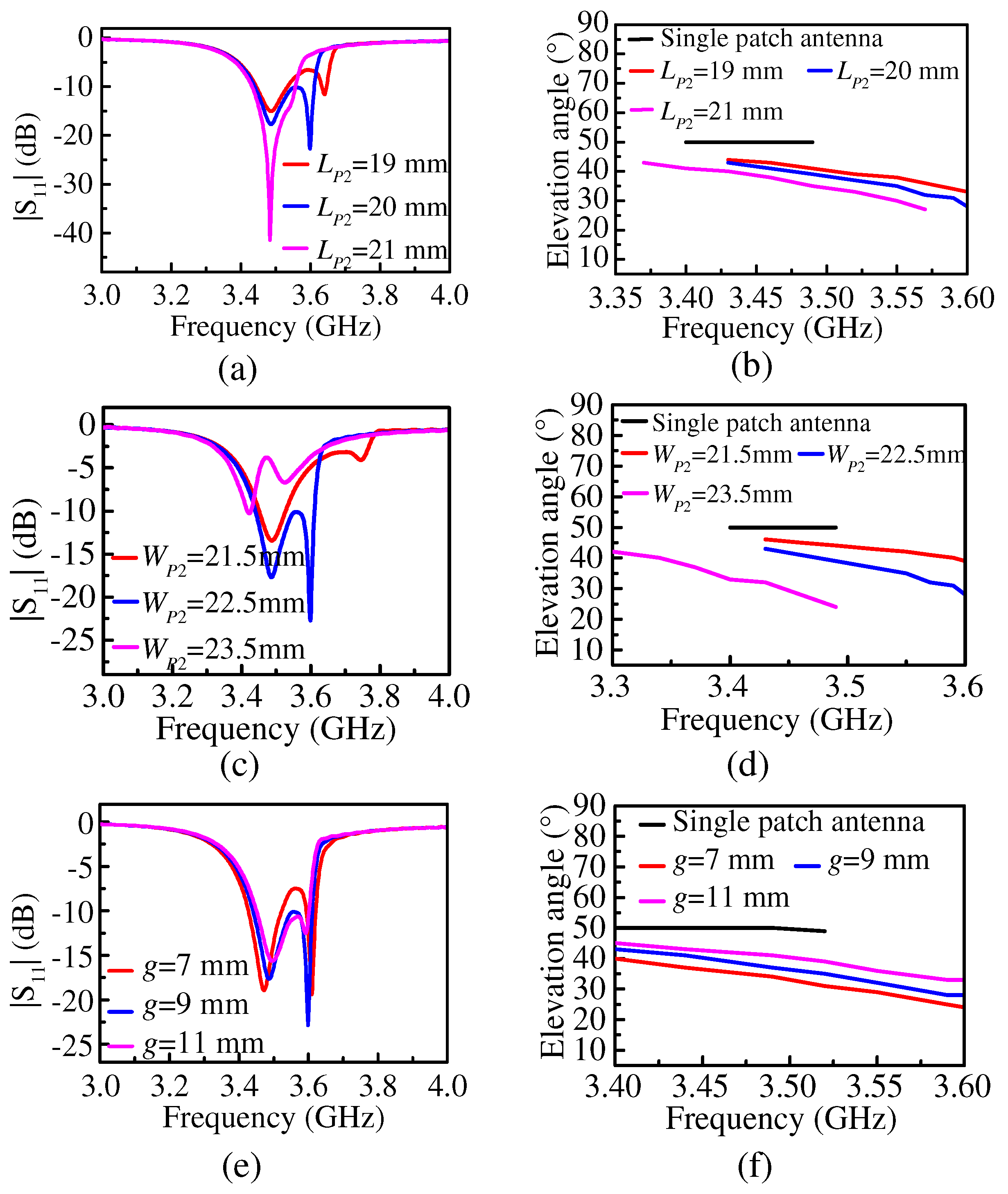



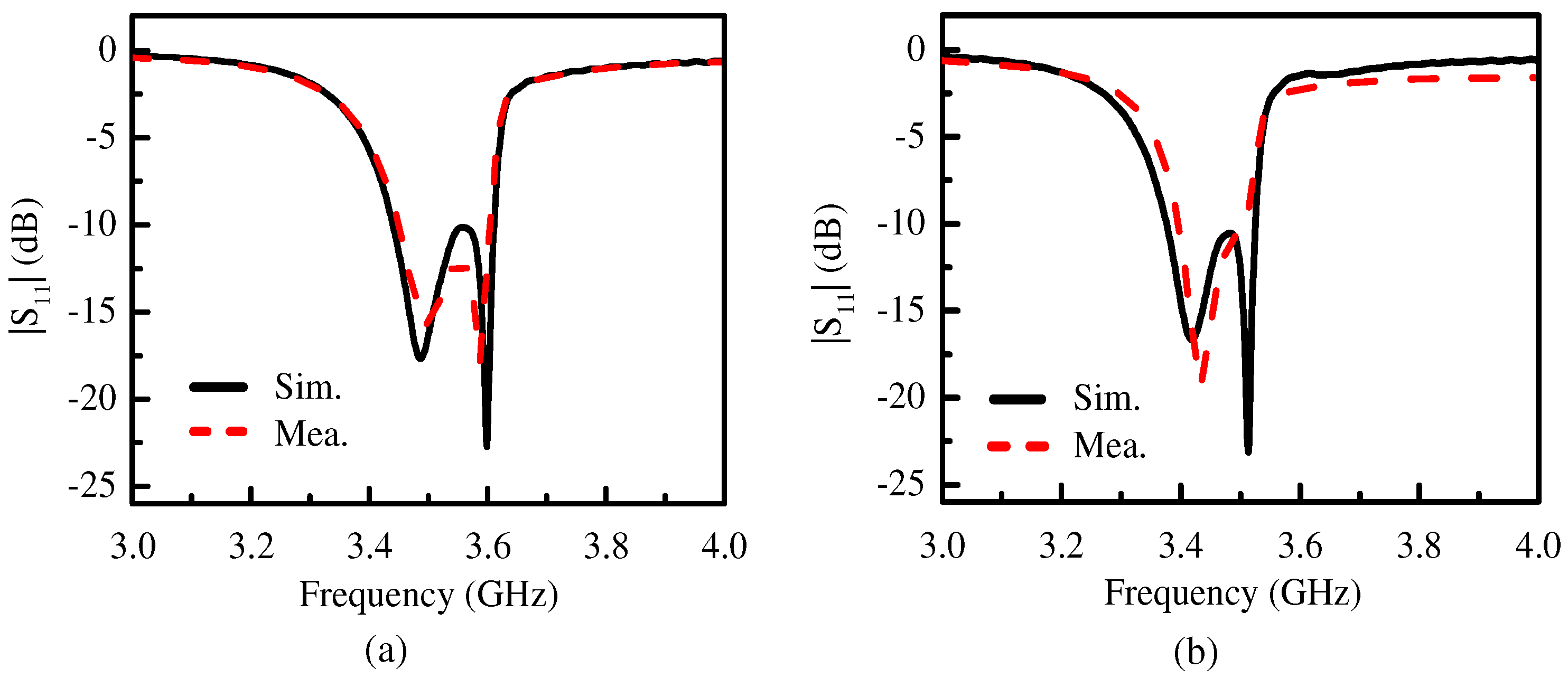
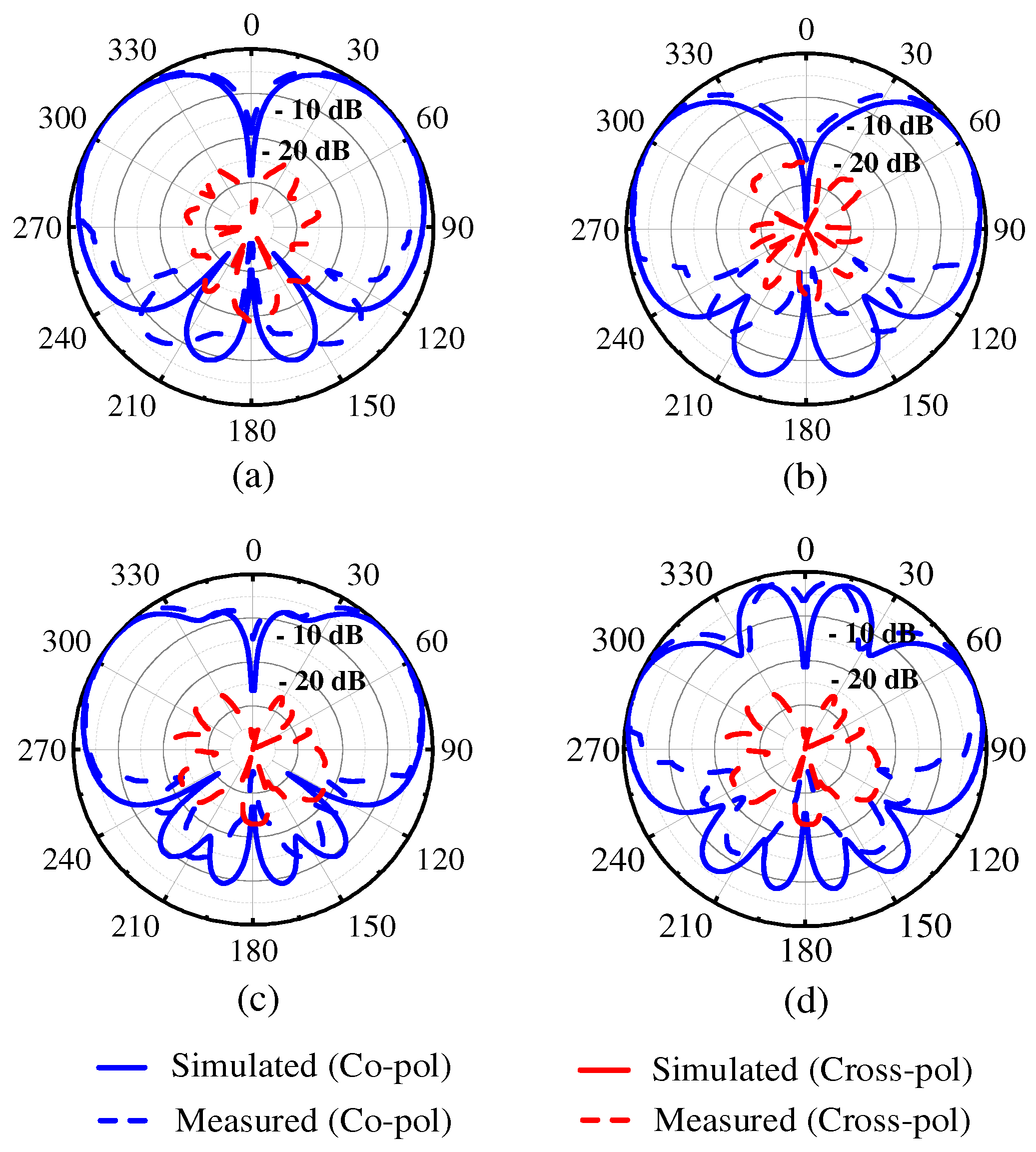
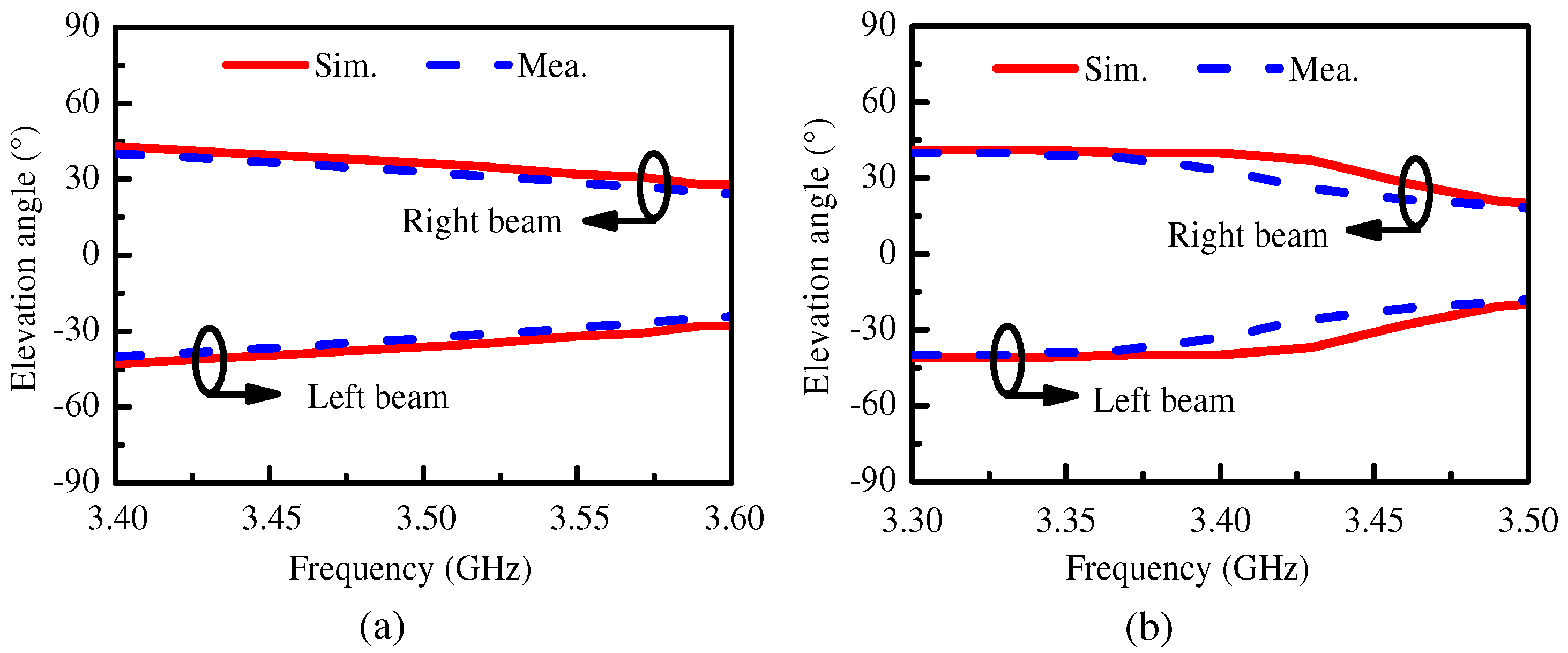
| Ref. | f01 (GHz) | Patch Dimensions (λ0 × λ0 2) | FBW 3 (%) | Profile (λ0) | EA 4 (°) | The Lowest EA (°) | Dual Beams | MCL 5 |
|---|---|---|---|---|---|---|---|---|
| [7] | 5.46 | 0.77 × 0.44 | 13.2 | 0.1 | ±58~±61 | ±58 | Y | M |
| [9] | 5.4 | 0.8 × 0.46 | 19.4 | 0.043 | ±50 | ±50 | Y | H |
| [12] | 5.5 | 0.62 × 0.49 | 11.8 | 0.058 | 49~53 | 49 | Y | L |
| [14] | 5.9 | 0.67 × 0.67 | 3 | 0.03 | ±45 | ±45 | Y | M |
| [16] | 5.5 | 0.57 × 0.48 | 17.5 | 0.04 | ±40 | ±40 | Y | H |
| [25] | 5.1 | 1.5 × 1 | 11.5 | 0.025 | 30~40 | 30 | N | L |
| [26] | 4.8 | 2.1 × 1.12 | 3.3 | 0.04 | 30~40 | 30 | N | M |
| Ant. 1 | 3.5 | 1.36 × 0.57 | 4.8 | 0.036 | ±28~±40 | ±28 | Y | L |
| Ant. 2 | 3.45 | 2.3 × 0.57 | 4.3 | 0.036 | ±19~±40 | ±19 | Y | L |
Disclaimer/Publisher’s Note: The statements, opinions and data contained in all publications are solely those of the individual author(s) and contributor(s) and not of MDPI and/or the editor(s). MDPI and/or the editor(s) disclaim responsibility for any injury to people or property resulting from any ideas, methods, instructions or products referred to in the content. |
© 2024 by the authors. Licensee MDPI, Basel, Switzerland. This article is an open access article distributed under the terms and conditions of the Creative Commons Attribution (CC BY) license (https://creativecommons.org/licenses/by/4.0/).
Share and Cite
Zhou, Z.; Shi, J.; Liu, G.; Xu, K.; Jiang, R. A Bidirectional Quasi-Endfire Patch Antenna with Low Elevation Angle. Micromachines 2024, 15, 777. https://doi.org/10.3390/mi15060777
Zhou Z, Shi J, Liu G, Xu K, Jiang R. A Bidirectional Quasi-Endfire Patch Antenna with Low Elevation Angle. Micromachines. 2024; 15(6):777. https://doi.org/10.3390/mi15060777
Chicago/Turabian StyleZhou, Ziling, Jin Shi, Gu Liu, Kai Xu, and Ruirui Jiang. 2024. "A Bidirectional Quasi-Endfire Patch Antenna with Low Elevation Angle" Micromachines 15, no. 6: 777. https://doi.org/10.3390/mi15060777





